Engineering Vision
Researchers are working to cure blindness with microchips and electrodes. Stephanie Pappas takes a close look. Illustrated by Noel Pugh and Lauren Hennessy.

Illustration: Noel Pugh
Linda Moorfoot couldn't understand why her vision was failing. At 21, unable to see objects right in front of her, she visited an ophthalmologist. The diagnosis was grim: The light-sensitive cells in her eyes were dying, snuffed out by retinitis pigmentosa, a rare and incurable genetic disorder. The doctor predicted Moorfoot would be blind by the time she was 30.
Moorfoot held out longer than her doctor expected. She spent the next three decades raising three daughters and learning the corners and edges of her Long Beach home by heart. But by age 52, the darkness closed in.
Eight years later, in May 2004, her doctor mentioned a new clinical trial at the University of Southern California. Researchers were developing a device to restore vision, he said, and were looking for retinitis pigmentosa patients like her. Intrigued, she went across town for testing. Months later, she learned she was eligible for a cutting-edge implant to replace her ruined rods and cones.
Moorfoot was used to blindness—“Never used a cane and never had a dog, just went about my business and doing all the things I ever did except drive,” she says—and was nervous at the prospect of surgery. She had no guarantee her sight would return. It wasn't until she was playing with her five-year-old grandson one day that she made her decision.
“He said, 'Well, Grandma, if you do this surgery will you be able to see me?'” she says. She remembers thinking that even if her vision didn't improve, she could help pioneer a cure for future generations.
A few months after that, Moorfoot became one of the first people to test the Argus 16, an artificial retina that lets her see lines, shadows, and the shapes of her grandchildren running across a soccer field.
The retinal replacement, a tiny implant that translates light into neural signals, was twenty years in the making. With funding from the National Science Foundation and the U.S. Department of Energy, a team of researchers at 11 institutions brought the device to clinical trials in 2002. Since then, they have reintroduced sight to dozens of patients in America, Europe, and Mexico. Now, the team is working to create a higher-resolution retinal prosthesis that will allow patients to see faces and even read large print.
From science fiction to fact
The project began with USC ophthalmologist Mark Humayun, who grew up watching his grandmother lose her vision to diabetes.
“I saw the problems of vision loss early and on a very personal level,” he says. “Even then, I made a commitment to being an eye doctor and doing what I could to alleviate the suffering and problems that blindness can bring.”
Years later, with treatments for degenerative retinal diseases still out of reach, Humayun approached Wentai Liu, an electrical engineer at North Carolina State University, and asked him to help build an electrical system to replace the retina.
“It sounds like a science fiction story,” says Liu, from his office overlooking the redwood trees at UC Santa Cruz, where he's worked since 2003. His walls are lined with awards and honors, including a Dutch textbook propped up on two nails. Inside is a picture of him holding the microchip that drives the artificial retina.
When Liu joined the project in 1988, the team didn't know if
stimulating the remaining cells in the eye of a retinitis pigmentosa
patient was possible. But circuits are one of Liu's passions, and he
jumped at the chance to design the mechanism. Liu says he has no financial stake in the artificial retina, which will be sold through
the Sylmar, Calif.-based company Second Sight.
And though he loves the work, he sometimes chafes under the hush-hush requirements of for-profit
engineering.
“I'm an academic,” he says. “I prefer to have free exchange of information.”
Liu does his engineering in a cramped fourth-floor lab filled with computers that hum and beep and heat the air. Spools and tangles of colorful wire litter a table near the door.
He eagerly shows off some of his team's latest projects: a wireless EEG cap, a microstimulator for the eyelid, a navy blue baseball cap with “Wentai Liu” embroidered in script and EEG-monitoring electrodes lining the band. You can wear it while you're driving, he explains, and if you begin to fall asleep, it will call your cell phone and wake you up.
But creating a circuit that works inside a living eyeball has been Liu's longest-running challenge.
Engineering in the eye
In a healthy eye, the lens focuses light onto the retina, a half-millimeter-thick tangle of light-sensitive cells coating the back of the eyeball. Here, the eye begins to organize light, sorting and translating wavelengths into neural pulses.
The pulses shoot down the optic nerve to the brain's visual cortex, where densely packed neurons synthesize information about color, orientation, and depth into faces, mountain vistas, or words on a page.
Any break in this chain can lead to blindness, but degenerative retinal disorders are untreatable. Vision researchers are testing new drugs and gene-therapy techniques but, Humayun points out, blindness is winning the race. His goal is not to slow or stop the progress of retinitis pigmentosa and related disorders, but to reverse the effects.
Although retinitis pigmentosa damages light-sensitive rods and cones, it generally spares the information-carrying cells layered over the photoreceptors. The artificial retina taps into these with a tiny array of electrodes. Patients wear a video camera on a pair of eyeglasses. As they move their heads to scan over objects, the camera wirelessly transmits images to a receiver, which rests under the skin either behind the ear or by the eye. From there, the signal travels to the array, which fires its own electric pulses down the optic nerve.
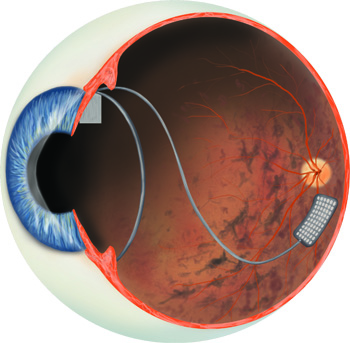 |
Illustration: Lauren Hennessy |
Humayun's team has tested the artificial retina only on patients with retinitis pigmentosa, which affects about 100,000 Americans. But the team also hopes to target age-related macular degeneration—one of the leading causes of blindness in the United States, affecting more than 1.7 million people.
To tackle a project this big, the researchers had to think small. The implant must fit into a space the size of a ping-pong ball—a wet, salty, corrosive ping-pong ball. The electrodes must stick to the fragile fabric of the inner eye. And to reduce the risk of infection, the engineers can't use wires to transmit either data or power.
“People always ask, hey, if an engineer can design a cell phone and receive information wirelessly, why is it difficult to transmit the camera data and receive video data to the eye?” Liu says, pulling his cell phone out of his pocket. “The reason is, the engineers that designed this one”—he waves the phone around—“they don't have any limitations on the size.”
When Moorfoot received her implant in 2004, she was one of six people testing the Argus 16, a model that already seems clunky. It has just 16 electrodes, and the inch-long transceiver that relays camera data and power to the array was scavenged from larger cochlear implants designed for the inner ear.
Still, the device satisfied some of the team's goals. Specially developed hermetic packaging kept the eyeball's fluids out of the circuits. The electrode array, tacked to the eye with a staple the width of a human hair, stayed put. Most importantly, the device worked: At first, Moorfoot saw specks of light, like an incomplete connect-the-dots puzzle. But as she practiced with the video glasses, learning how the world matched up to this new version of vision, the dots crystallized into lines, cueing her in to edges and corners.
And Liu's circuits kept the whole thing running.
The circuits transfer energy wirelessly from battery pack to implant using two coils to create a magnetic field, which is then converted to electricity. The system is also what Liu calls “intelligent.” When the user looks at something bright, the circuits sense the need for extra power. If one patient wears her glasses farther out on her nose than another, the system can sense that too, ramping up the signals from the camera to the receiver.
And no, you can't leave the glasses at a neighbor's house and use them as a spy-cam; the video signal travels only a few centimeters. Still, the device has its moments. Moorfoot once forgot to switch the camera off while on a Disneyland rollercoaster. She squeezed her eyes shut on the ride, but to no avail. The camera kept flashing dizzying light right to her optic nerve.
Seeing red (tape)
After the success of Argus 16, the team scaled the power up and the size down. The Argus II, which began clinical trials in the United States in 2006, has 60 electrodes and a transceiver the size of an aspirin.
As the electronics gets smaller and the amount of data to transfer grows, Liu has had to develop more powerful chips. More power means more heat. That's fine for a cell phone, but it's not so great for the human body. “We cannot allow the temperature to rise more than one degree Celsius,” Liu says, “because it would damage the eye.”
Besides abiding by National Institute of Standards and Technology standards on heat, Liu and his team also must answer to the Federal Communications Commission, which regulates radio frequency.
“Those regulations are one of the toughest challenges,” says Moo Sung Chae, a graduate student who has worked with Liu for four years. The team once had to redesign a microchip when the chip's frequency interfered with AM radio.
To shepherd the project through yet another layer of regulations—stringent U.S. Food and Drug Administration protocols for clinical trials—Humayun's group partnered with Second Sight in 1998. The decision to go commercial catapulted the team over similar efforts around the country, including a Veterans Affairs-funded collaboration in Boston.
“It's tough to do it with fewer resources,” says Shawn Kelley, a researcher for the Boston group.
With Second Sight behind them, Humayun's group has met success in clinical trials. Four of the six original Argus 16 patients still use their retinal implants (the other two have since died of unrelated causes). And nine of the ten patients implanted with the 60-electrode Argus II are still using it.
But the device isn't perfect yet, cautions Brian Mech, vice president of business development at Second Sight, noting that the clarity of sight varies from patient to patient. Researchers are still teasing out why, but the original condition of the retina and the type of genetic mutation causing the retinitis pigmentosa may make a difference. Other possible factors are the degree to which each individual's brain can "re-wire" itself, and the recipient's enthusiasm for the training.
Starry-eyed
One enthusiastic recipient is Dean Lloyd, a 68-year-old Palo Alto lawyer who developed retinitis pigmentosa during medical school. He had to drop out when he could no longer see through the microscope, but he went on to work as a biochemist and then as a software engineer before switching to law.
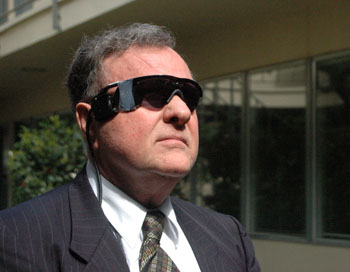 |
Photo: Stephanie Pappas |
Retinal implant recipient Dean Lloyd wears his video glasses outside his law offices in Palo Alto, California.
|
|
Lloyd found out about the Argus II trials through his daughter, Lisa, who works for Foundation Fighting Blindness in Northern California. The organization put up seed money for initial development of the device. Lloyd didn't hesitate to apply, and on July 10, 2007, he became the seventh person in the United States implanted with the Argus II.
The path hasn't been completely smooth. Lloyd had a second surgery to re-tack the electrode patch because not all of the electrodes were resting flush against his retina. And because some of the outermost electrodes need more power than the FDA has approved, he isn't using the full array of 60 dots.
Lloyd's experience provides some insight into the differences between the Argus 16 and the Argus II. At various points, he's had as few as nine and as many as 52 electrodes firing. Boundaries get sharper as the number of electrodes go up, he says, using the example of a statue he saw the first time he walked outside wearing video glasses. With nine electrodes active, he knew something was there, but couldn't tell what. Now, he says, the borders are crisper, though not crisp enough to discern the statue's face.
The world through the Argus might look a bit like opening a black-and-white picture on Photoshop, upping the contrast, lowering the brightness, and throwing in some pixellation. Sharply contrasting areas remain, but their resolution isn't high. Moorfoot describes lines lighting up as she scans over things. Lloyd can see the reflection of moisture in people's eyes, “like a cat under a bed where you shine a flashlight.” He sees shapes in flashes of light: cars coming by, his daughter's hands.
“People come up to me and ask, “What do I look like?” he says. His response? “Oh, you are a star, in fact you're many of them.”
Lloyd still travels to San Francisco for visual training. He's working on spatial recognition—figuring out how the lines and borders he sees relate to one another. It's a learning process he's introduced into his daily life, as well. When he sees a flash of light from his implant, he makes a point to explore the object that triggered the electrodes. He's taught himself to recognize doorframes and the curb along his favorite walking path.
“I'm not gonna throw out my hickory [walking] stick,” Lloyd says. “It's vision that's useful, but in a different way.”
Like Moorfoot, Lloyd says he wanted to be a part of the study for the sake of future generations. His daughter Lisa Lloyd has a mosaic case of retinitis pigmentosa—some of her retinal cells are affected, while others are healthy.
“Definitely progress is happening in this area,” she says. “It's really exciting for people like me who are slowly going blind. You just think, oh, is there anything out there for me, am I going to be okay?”
Others strike a cautious tone. Frank Welte, director of advocacy and government for the California Council of the Blind, calls the research “interesting,” but warns it could be decades before science accurately mimics human sight.
“If there were something developed for my situation, I might be interested in it,” says Welte, who has retinopathy of prematurity, a disorder that strikes preterm babies and made him blind at birth. “But I'm not putting my life on hold waiting.”
Second Sight expects the Argus II to be its first commercially available device, hitting the United States market in 2010. Mech said the company hasn't set a price, but suggested the Argus II would cost more than a cochlear implant. That could put the price between $60,000 and $100,000. Meanwhile, he hopes to start clinical trials in 2011 for a third generation of the device with more than 200 electrodes.
Looking to the future
The team's grand aim is to develop a device with more than 1,000 electrodes that can fit inside the eye, camera and all. The design would allow users to take advantage of their natural eye movements instead of having to turn their heads to scan over objects.
The scientists also are trying to determine how many more electrodes they will need for patients to recognize faces and read large print. After all, 1,000 still falls far short of the millions of light receptors in a healthy retina. Simulations suggest that better acuity is possible, says Liu, but until the 1,000-electrode device is tested in humans, there's no way to be sure. And no one seems quite confident that the camera-in-the-eye design is feasible anytime soon.
Right now, the next-generation microchip waits in Liu's lab. Under the microscope, the chip is a sleek gold grid with spaces for 256 electrodes. It can easily be scaled up to 1,024 electrodes, Liu says. But with that will come challenges for power and data transmission.
For Liu, it's a project worth pursuing. He sees bioengineering as the future, a way to help the less fortunate and solve societal problems.
Lloyd and Moorfoot look forward to that future as well, and hope they have been a part of making it real. In the meantime, they and others like them will keep navigating a world painted with lights and lines and stars.
“I just have fun with it,” Moorfoot says. “I'm waiting for them to improve it and do something better, like when they get the 250 and the 1,000. If I'm not too old, I'll do it again.”
Editor's note: In August 2009, R&D magazine awarded its prestigious
R&D 100 Award to the artificial retina project, recognizing it as
one of the nation's most innovative ideas in research and engineering.
Story ©2009 by Stephanie Pappas. For reproduction requests, contact the Science Communication Program office.
Top
Biographies
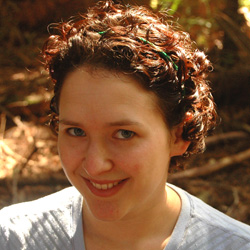 Stephanie Pappas Stephanie Pappas
B.A. (psychology) University of South Carolina
Internship: Stanford Medical Center news office
I made my way to California incrementally, hop-skipping from the sand hills of South Carolina to the thin-aired Rockies, and finally alighting in the redwood forests of Santa Cruz.
My journey into science writing has been much the same. I rebelled against crunching numbers in a neuroscience lab; instead, I spent valuable data-gathering time listening to the life stories of our study participants. Concluding that I was more interested in people than in science, I landed in education. I taught children with autism, but I found that I wanted to know how their brains worked. My mistake was in believing that science and people occupy separate spheres. Science writing is my way of exploring both. And whether I find myself in South Carolina or Santa Cruz, I know there will be stories to tell.
. . . . . . . . . . . . . . . . . . . . . . . . . . . . . . . . . . . . . . . . . . . . . . . . . . .
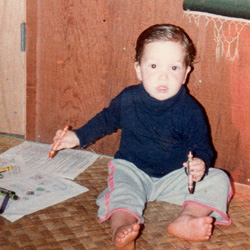 Noel Pugh Noel Pugh
B.F.A. (painting) San Francisco Art Institute
Internship: Illustrating a field guide of native bees for researcher Gretchen LeBuhn, San Francisco State University
Whether pondering the birth of a cloud while lying in the grass, or studying the proboscis of a bee while looking through a magnifying glass, my heart and mind are forever turned to illustrating this world, which is full of wonder.
. . . . . . . . . . . . . . . . . . . . . . . . . . . . . . . . . . . . . . . . . . . . . . . . . . .
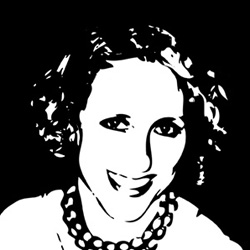
Lauren Q. Hennessy
B.A. (fine art) UC Santa Cruz
Internship: UC Davis Tahoe Environmental Research Center, Tahoe City, CA
When choosing a direction to go in college, I was torn between my passions for drawing and science. I quickly fell in love with the printmaking department at UCSC and decided to pursue a degree in studio art. During one of my first art courses, I was encouraged by the professor to look into the Science Illustration Program. I then realized I didn't have to make a clear distinction between art and science and could have a career combining them. To see more examples of my work, see my web site.
Top |

